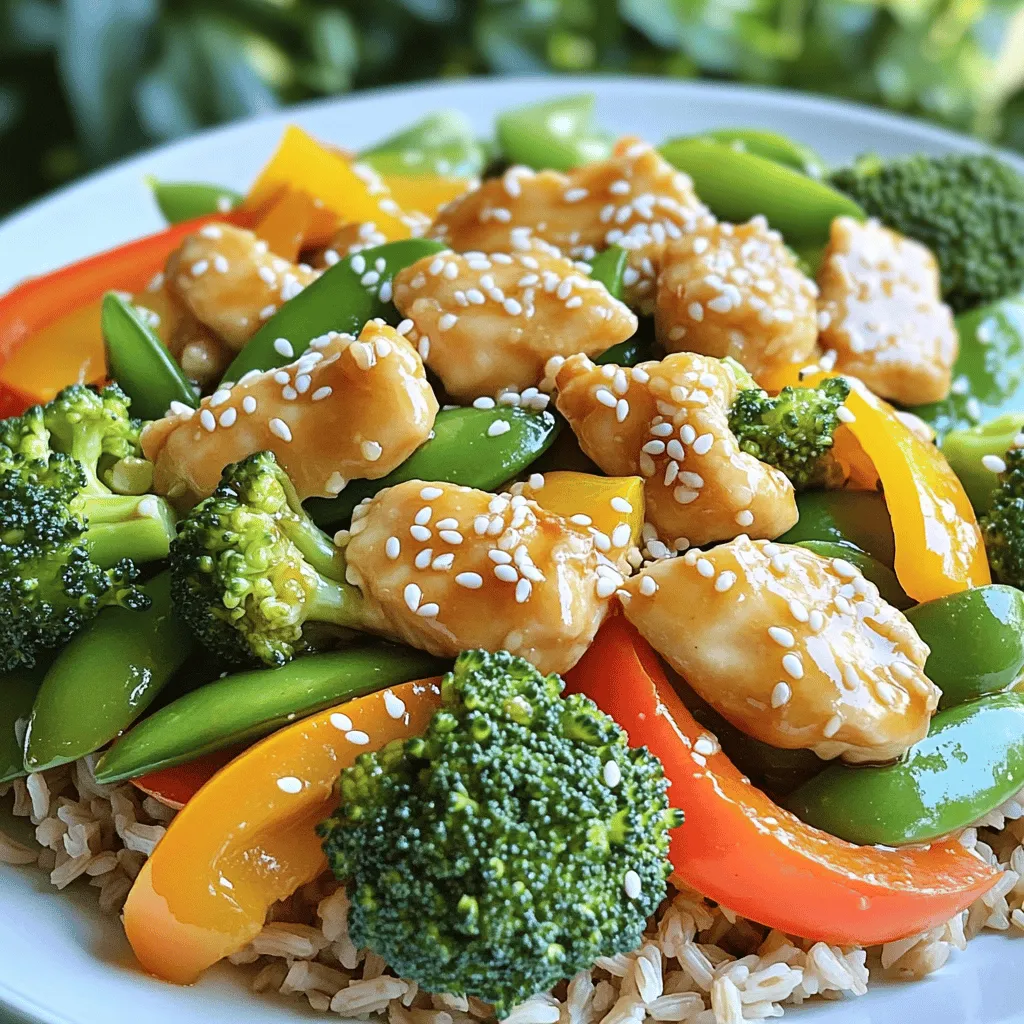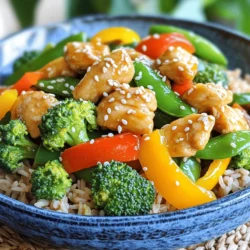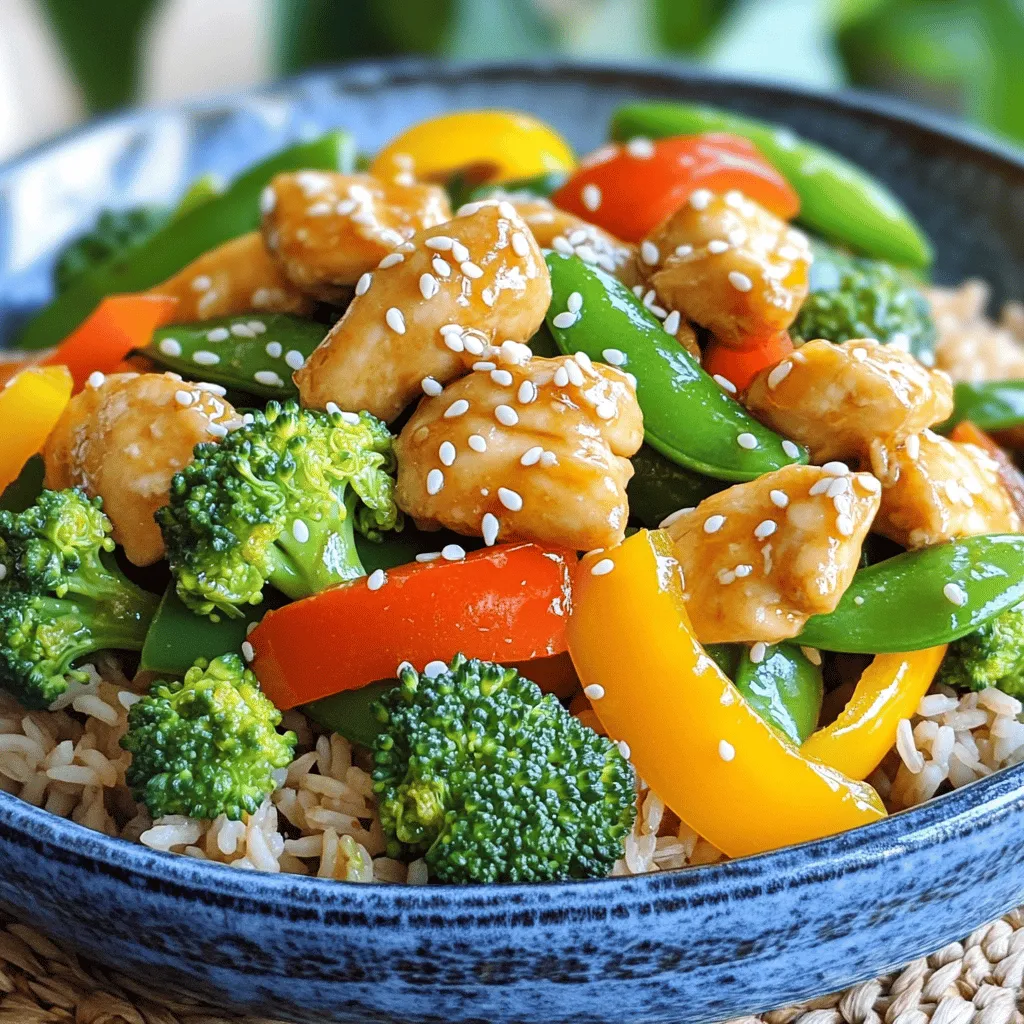Looking for a quick, tasty meal that’s also good for you? My Healthy Sesame Chicken Stir Fry is your answer! With lean protein, vibrant veggies, and rich flavors, this dish is simple to make and packed with nutrition. You’ll be surprised how effortless it is to whip up this delicious meal. Let’s dive in and make cooking fun and healthy together!
Ingredients
Main Ingredients
- Lean Protein Options
For this dish, I use 1 lb of boneless, skinless chicken breast. This choice offers a healthy protein source. You can also try tofu or shrimp if you want a different flavor.
- Vegetables for Nutritional Value
I include colorful bell pepper, broccoli florets, snap peas, and carrots. These veggies give the stir fry vitamins and minerals. They also add crunch and bright colors to your meal.
- Flavor Enhancers (Sauces, Spices)
I use sesame oil for a nutty taste. Low-sodium soy sauce adds salt without being too heavy. Honey or maple syrup gives a touch of sweetness. Fresh garlic and ginger make the dish fragrant and delicious. I finish with sesame seeds for a lovely crunch.
Step-by-Step Instructions
Preparation and Marination
How do you properly marinate chicken?
To marinate chicken, start with a bowl. Add the sliced chicken, 1 tablespoon of sesame oil, low-sodium soy sauce, honey, salt, and pepper. Mix it well to coat all the chicken pieces. Let it sit for at least 15 to 20 minutes. This step helps the chicken soak up flavors and stay juicy.
What is the recommended marination time?
A good marination time is about 15 to 20 minutes. This short time works well for thinly sliced chicken. If you marinate too long, it can become too salty.
Cooking the Chicken
What are the best techniques for cooking chicken?
Heat a large skillet or wok over medium-high heat. Add the remaining sesame oil. Once hot, add the marinated chicken. Cook it for about 5 to 7 minutes. Stir occasionally, letting it turn golden brown. This method ensures even cooking and great flavor.
What are the signs of chicken doneness?
The chicken is done when it turns golden brown and no longer pink inside. You can cut a piece to check. If the juices run clear, it’s ready to go.
Stir-Frying Vegetables
What are the ideal vegetable cooking times?
Add garlic and ginger first, cooking for about 30 seconds. Then, toss in the sliced bell pepper, broccoli, snap peas, and carrot. Stir-fry these veggies for about 5 minutes. You want them tender but still crisp.
How do you maintain crispness and flavor?
Stir-frying at high heat helps keep veggies crisp. Avoid overcooking, as this can make them mushy. Quick cooking also locks in their bright flavors and nutrients.
Tips & Tricks
Reducing Fat and Calories
Healthier Cooking Methods
To cut fat, you can use less oil. Try using a non-stick pan. You can also steam or stir-fry with water. This keeps the flavors without adding extra fat.
Ingredient Substitutions
Swap regular soy sauce for low-sodium soy sauce. This helps reduce salt. You can also use honey or maple syrup for a natural sweetener. If you want to add crunch, try using air-fried or baked chicken instead of fried.
Flavor Enhancement Tips
Spicing Up Your Stir Fry
Add crushed red pepper flakes for heat. You can also use fresh herbs like cilantro or basil for freshness. A dash of lime juice can brighten the dish too.
Balancing Sweetness and Saltiness
Taste as you cook! If it’s too sweet, add a splash of soy sauce. If it’s too salty, add more veggies or a bit of brown rice to balance it out.
Presentation Techniques
Garnishing Tips
Garnish with extra sesame seeds for crunch. A sprinkle of chopped green onions adds color and freshness. You can also use thin slices of red chili for a pop of color.
Serving Suggestions
Serve your stir fry over brown rice or quinoa. This makes a filling meal. You can also pair it with a side salad for added greens. Enjoy your beautiful dish!

Variations
Protein Alternatives
You might want to switch up the protein in your stir fry. Tofu or shrimp are great options.
- Tofu: Use firm tofu. Cut it into cubes and press it to remove excess water. Marinate it just like chicken. This option is vegan and rich in protein.
- Shrimp: Use peeled shrimp for a quick cook. Add them to the skillet after the vegetables. They cook fast and add a sweet taste.
Nutritional Considerations
Both tofu and shrimp have their benefits. Tofu is plant-based and offers healthy fats. Shrimp is low in calories and high in protein. Choose based on your diet needs.
Vegetable Swaps
You can easily swap in different veggies. Seasonal vegetables work best for fresh flavor.
- Spring: Try asparagus or snap peas.
- Summer: Use zucchini or bell peppers.
- Fall: Add squash or Brussels sprouts.
- Winter: Use kale or root vegetables.
Additional Add-ins for Flavor
Want extra flavor? You can add:
- Mushrooms for umami
- Baby corn for crunch
- Bok choy for a unique taste
These additions make your dish even better.
Sauce Adjustments
You have options for the sauce. Homemade sauces give you more control.
- Homemade: Mix soy sauce, honey, and sesame oil. You can add garlic and ginger for depth.
- Store-bought: Look for low-sodium options for health. Check for added sugars.
Adjusting Sweetness Levels
Some may like it sweeter. Add more honey or maple syrup if desired. If it’s too sweet, add more soy sauce or a splash of vinegar for balance. Adjust it to your taste!
Storage Info
Storing Leftovers
To keep your Healthy Sesame Chicken Stir Fry fresh, use airtight containers. Glass or plastic containers with tight lids work best. These containers prevent air from seeping in and keep the food safe.
In the fridge, your stir fry lasts about three to four days. If you want to store it longer, place it in the freezer. In the freezer, it stays good for up to three months. Make sure to label the containers with the date. This helps you remember when you made it.
Reheating Instructions
The safest way to reheat your stir fry is in the microwave. Place the stir fry in a microwave-safe dish. Cover it with a lid or a damp paper towel to keep moisture in. Heat it in short bursts of one to two minutes. Stir in between to ensure even heating.
If you prefer, you can also reheat it on the stove. Use a non-stick pan over medium heat. Add a splash of water or broth to keep it moist. Stir often to avoid burning.
To keep the dish tasty, avoid overheating. If you cook it too long, the chicken can become dry. Add a splash of soy sauce or sesame oil when reheating for extra flavor. Enjoy your delicious meal!
FAQs
Common Questions About Healthy Sesame Chicken Stir Fry
Can I use frozen vegetables?
Yes, you can use frozen vegetables. They save time and are easy to find. Just add them straight to the pan without thawing. Cook them a little longer to ensure they heat through.
Is this recipe gluten-free?
The recipe is not gluten-free due to soy sauce. You can use gluten-free soy sauce instead. This keeps the flavor but makes it safe for those with gluten issues.
How can I make it spicier?
To add heat, use red pepper flakes or sriracha. You can also add fresh chopped chili peppers. Start with a small amount, then taste and adjust.
Nutritional Information
Caloric Breakdown per Serving
Each serving has about 350 calories. This includes protein from chicken and fiber from veggies. It’s a balanced meal to keep you full.
Health Benefits of Ingredients
- Chicken provides lean protein, which builds muscle.
- Broccoli is high in vitamins and supports your immune system.
- Carrots offer beta-carotene, great for your eyes.
- Sesame seeds add healthy fats and minerals.
Cooking for Meal Prep
How to Make Ahead of Time
You can marinate the chicken a day ahead. Cut and store veggies in the fridge for easy use. Cook the stir fry and divide into containers for meals.
Best Practices for Meal Prep and Storage
Use airtight containers to keep food fresh. Store in the fridge for up to four days. Reheat in the microwave or on the stove for best results.
This blog covered how to make a healthy sesame chicken stir fry. We looked at key ingredients, like lean protein and fresh veggies. You learned the best ways to prepare, cook, and flavor your dish. We shared tips for reducing fat and ways to present your meal nicely. You can even switch up proteins and veggies. Don’t forget about storing leftovers and reheating well. With all this, you can enjoy a tasty, nutritious dish that fits your health goals. Now, it’s time to get cooking!


